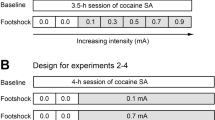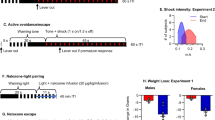Abstract
Rationale
We recently described a reinstatement procedure that models relapse to drug abuse in cases where abstinence results from aversive consequences of drug use. The potential value of this punishment-based model of relapse depends on its sensitivity to relapse-inducing events that are ineffective in the widely used extinction-based model.
Objectives
It is known that certain drugs can have antipunishment effects, but these drugs have not been tested in the punishment-based reinstatement procedure. Therefore, the effects of the benzodiazepine, lorazepam, were examined using punishment-based and extinction-based reinstatement procedures.
Methods
Rats self-administered the opioid, remifentanil (4 μg/kg per infusion). Two punishment groups were trained with response-contingent footshock that suppressed baseline rates of responding to zero. In an extinction group, remifentanil delivery was discontinued, and baseline responding stabilized at a low rate (mean=0.06 responses/min). Lorazepam (0.08–10 mg/kg, IP) was given during test sessions with the shock contingency discontinued for both punishment groups. Remifentanil delivery was maintained during testing in one punishment group but not the other.
Results
Lorazepam reinstated self-administration responding in both punishment groups but not in the extinction group. Priming injections of heroin reinstated responding in both the punishment and extinction groups, but combining heroin and lorazepam did not enhance reinstatement.
Conclusions
This is the first demonstration that a trigger for relapse may have different effects depending on whether aversive conditioning contributed to the achievement of abstinence. It may be important to consider potential antipunishment effects of both abused drugs and therapeutic agents in the treatment of individuals with a history of drug abuse.





Similar content being viewed by others
References
Azrin NH, Holz WC (1966) Punishment. In: Honig WK (ed) Operant behavior: areas of research and application. Prentice-Hall, Englewood Cliffs, pp 380–447
Baldwin HA, Wall TL, Schuckit MA, Koob GF (1991) Differential effects of ethanol on punished responding in the P and NP rats. Alcohol Clin Exp Res 15:700–704
Bergman J, Johanson CE (1991) The effects of electric shock on responding maintained by cocaine in rhesus monkeys. Pharmacol Biochem Behav 14:423–426
Bergman J, Katz JL (1998) Behavioral pharmacology of cocaine and the determinants of abuse liability. In: Higgins ST, Katz JL (eds) Cocaine abuse: behavior, pharmacology, and clinical applications. Academic, New York, pp 51–79
Bialik RJ, Pappas BA, Pusztay W (1982) Chlordiazepoxide-induced released responding in extinction and punishment-conflict procedures is not altered by neonatal forebrain norepinephrine depletion. Pharmacol Biochem Behav 16:279–283
Brewer C (1993) Recent developments in disulfiram treatment. Alcohol Alcohol 28:383–395
Brown RT, Wagner AR (1964) Resistance to punishment and extinction following training with shock or nonreinforcement. J Exp Psychol 68:503–507
Buckland C, Mellanby J, Gray JA (1986) The effects of compounds related to gamma-aminobutyrate and benzodiazepine receptors on behavioural responses to anxiogenic stimuli in the rat: extinction and successive discrimination. Psychopharmacology 88:285–295
Burman S (1997) The challenge of sobriety: natural recovery without treatment and self-help groups. J Subst Abuse 9:41–61
Carroll ME (1998) Acquisition and reacquisition (relapse) of drug abuse: modulation by alternative reinforcers. NIDA Res Monogr 169:6–25
Chait LD, Wenger GR, McMillan DE (1981) Effects of phencyclidine and ketamine on punished and unpunished responding by pigeons. Pharmacol Biochem Behav 15:145–148
Childress AR, McLellan AT, O’Brien CP (1985) Behavioral therapies for substance abuse. Int J Addict 20:947–969
Commissaris RL, Hill TJ, McMiller LV Jr, Kleinsorge RJ (1995) Initial subsensitivity to anxiolytic treatments on conflict behavior in rats: parametric studies across drug classes. Pharmacol Biochem Behav 51:391–396
Cook L, Davidson AB (1973) Effects of behaviorally active drugs in a conflict-punishment procedure in rats. In: Garattini S, Mussini E, Randall LO (eds) The benzodiazepines. Raven, New York, pp 327–345
Criswell HE, Breese GR (1989) A conflict procedure not requiring deprivation: evidence that chronic ethanol treatment induces tolerance to the anticonflict action of ethanol and chlordiazepoxide. Alcohol Clin Exp Res 13:680–685
Crowley TJ (1985) Doctors’ drug abuse reduced during contingency-contracting treatment. Alcohol Drug Res 6:299–307
Cunningham JA, Lin E, Ross HE, Walsh GW (2000) Factors associated with untreated remissions from alcohol abuse or dependence. Addict Behav 25:317–321
Feldon J, Gray JA (1981) The partial reinforcement extinction effect after treatment with chlordiazepoxide. Psychopharmacology 73:269–275
File SE (1985) Tolerance to the behavioral actions of benzodiazepines. Neurosci Biobehav Rev 9:113–121
File SE, Wilks LJ, Mabbutt PS (1988) Withdrawal, tolerance and sensitization after a single dose of lorazepam. Pharmacol Biochem Behav 31:937–940
Fontana DJ, Commissaris RL (1992) Anxiolytic-like effects of alpha-2-adrenoceptor agonists on conflict behavior in the rat: pre- versus postsynaptic receptor mechanisms. Pharmacol Biochem Behav 43:697–704
Frawley PJ, Smith JW (1992) One-year follow-up after multimodal inpatient treatment for cocaine and methamphetamine dependencies. J Subst Abuse Treat 9:271–286
Grove RN, Schuster CR (1982) Suppression of cocaine self-administration by extinction and punishment. Pharmacol Biochem Behav 2:199–208
Howard JL, Rohrbach KW, Pollard GT (1982) Cumulative dose–effect curves in a conflict test with incremental shock. Psychopharmacology 78:195–196
Johanson CE (1977) The effects of electric shock on responding maintained by cocaine injections in a choice procedure in the rhesus monkey. Psychopharmacology 53:277–282
Johanson CE, Schuster CR (1986) The effects of Ro 15-1788 on anxiolytic self-administration in the rhesus monkey. Pharmacol Biochem Behav 24:855–859
Kelleher RT, Morse WH (1964) Escape behavior and punished behavior. Fed Proc 23:808–817
Kelleher RT, Morse WH (1968) Determinants of the specificity of behavioral effects of drugs. Ergeb Physiol 60:1–56
Klingemann HK (1991) The motivation for change from problem alcohol and heroin use. Br J Addict 86:727–744
McMillan DE, Hardwick WC, deCosta BR, Rice KC (1991) Effects of drugs that bind to PCP and sigma receptors on punished responding. J Pharmacol Exp Ther 258:1015–1018
Miczek KA, Lau P (1975) Effects of scopolamine, physostigmine and chlordiazepoxide on punished and extinguished water consumption in rats. Psychopharmacologia 42:263–269
Morris MD, Tremmel F, Gebhart GF (1974) Forebrain noradrenaline depletion blocks the release by chlordiazepoxide of behavioral extinction in the rat. Neurosci Lett 12:343–348
Panlilio LV, Thorndike EB, Schindler CW (2003) Reinstatement of punishment-suppressed opioid self-administration in rats: an alternative model of relapse to drug abuse. Psychopharmacology 168:229–235
Porter JH, Wiley JL, Balster RL (1989) Effects of phencyclidine-like drugs on punished behavior in rats. J Pharmacol Exp Ther 248:997–1002
Shaham Y, Erb S, Stewart J (2000) Stress-induced relapse to heroin and cocaine seeking in rats: a review. Brain Res Brain Res Rev 33:13–33
Shaham Y, Shalev U, Lu L, De Wit H, Stewart J (2003) The reinstatement model of drug relapse: history, methodology and major findings. Psychopharmacology 168:3–20
Slikker W Jr, Brocco MJ, Killam KF Jr (1984) Reinstatement of responding maintained by cocaine or thiamylal. J Pharmacol Exp Ther 228:43–52
Smith SG, Davis WM (1974) Punishment of amphetamine and morphine self-administration behavior. Psychol Rec 24:477–480
Vogel RA, Frye GD, Wilson JH, Kuhn CM, Koepke KM, Mailman RB, Mueller RA, Breese GR (1980) Attenuation of the effects of punishment by ethanol: comparisons with chlordiazepoxide. Psychopharmacology 71:123–129
Walker B, Ettenberg A (2001) Benzodiazepine modulation of opiate reward. Exp Clin Psychopharmacol 9:191–197
Walker BM, Ettenberg A (2003) The effects of alprazolam on conditioned place preferences produced by intravenous heroin. Pharmacol Biochem Behav 75:75–80
Weerts EM, Griffiths RR (2003) The adenosine receptor antagonist CGS15943 reinstates cocaine-seeking behavior and maintains self-administration in baboons. Psychopharmacology 168:155–163
Witkin JM, Barrett JE (1976) Effects of pentobarbital on punished behavior at different shock intensities. Pharmacol Biochem Behav 5:535–538
Author information
Authors and Affiliations
Corresponding author
Rights and permissions
About this article
Cite this article
Panlilio, L.V., Thorndike, E.B. & Schindler, C.W. Lorazepam reinstates punishment-suppressed remifentanil self-administration in rats. Psychopharmacology 179, 374–382 (2005). https://doi.org/10.1007/s00213-004-2040-2
Received:
Accepted:
Published:
Issue Date:
DOI: https://doi.org/10.1007/s00213-004-2040-2




